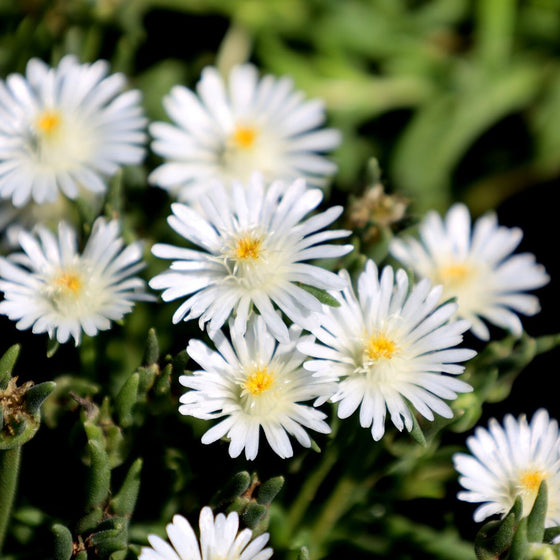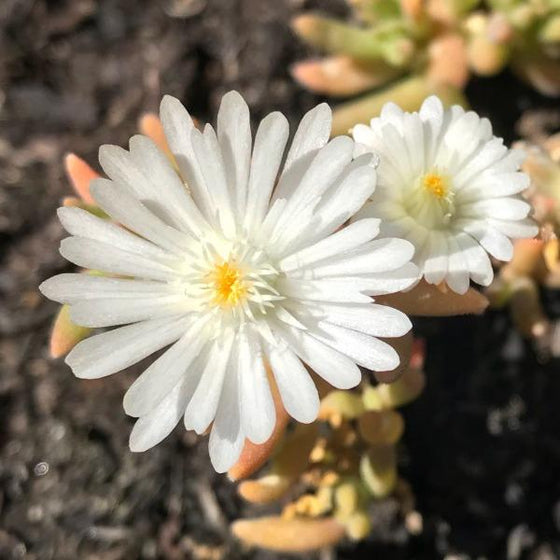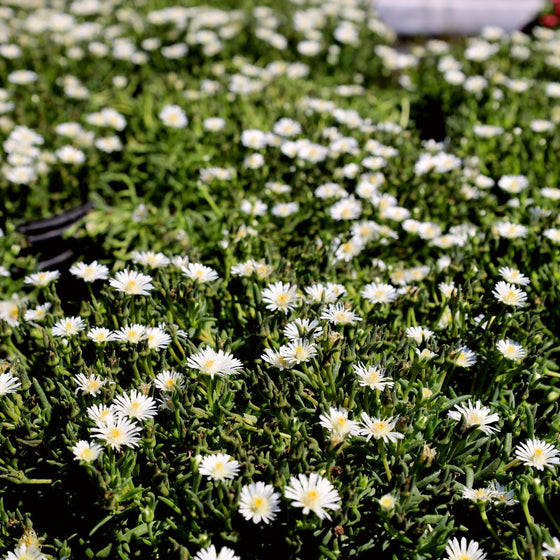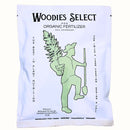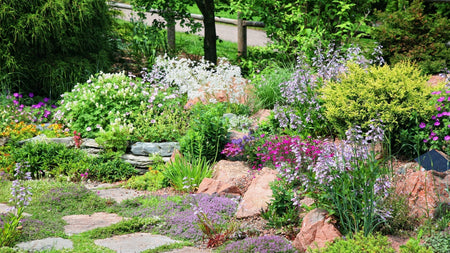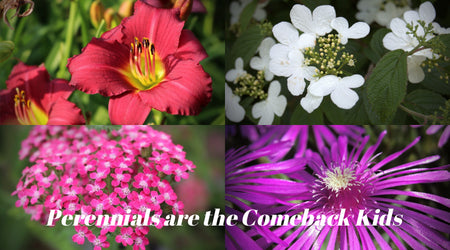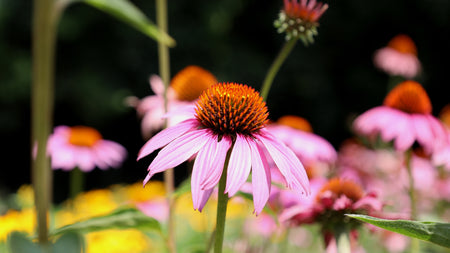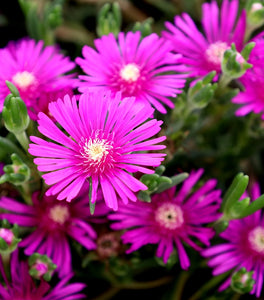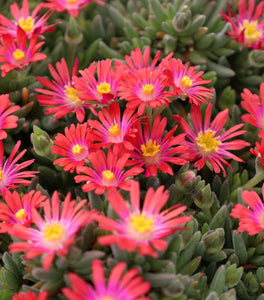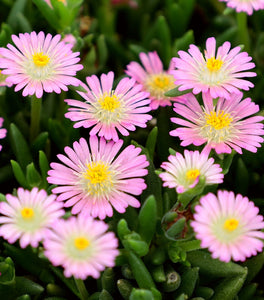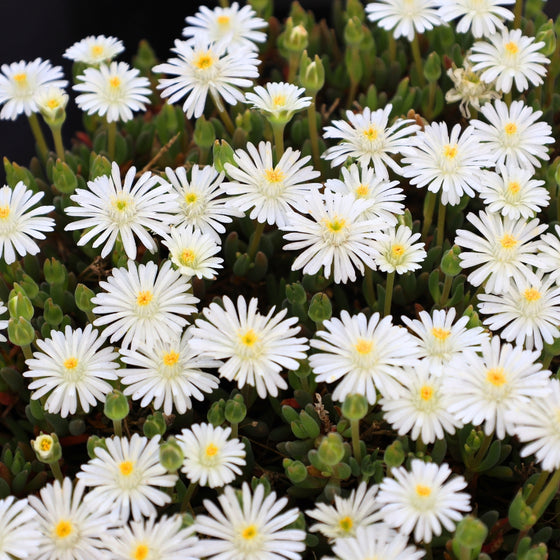
Images Depict Mature Plants
Delosperma Jewel of the Desert Moonstone Ice Plant
Delosperma 'Jewel of the Desert Moonstone' is a dazzling, low-growing succulent groundcover known for its luminous lavender and white bi-color blooms. From late spring through fall, this hardy ice plant produces an abundance of daisy-like flowers with pale purple petals and radiant white centers, creating a glowing effect across rock gardens, borders, and sunny slopes. Its long bloom period and vivid coloring make it an eye-catching addition to water-wise and low-maintenance landscapes, while its compact growth—reaching only 2 to 4 inches tall and spreading up to 18 inches wide—makes it ideal for filling gaps between stones, edging pathways, or spilling gracefully from containers.
Thriving in full sun and well-drained soil, Jewel of the Desert Moonstone Delosperma is exceptionally drought tolerant and heat resistant, making it perfect for xeriscaping and high-exposure areas where other plants may struggle. Its evergreen succulent foliage forms a dense, weed-suppressing mat that retains visual appeal even when not in bloom. Resistant to deer and tolerant of poor soils, this easy-care perennial also attracts pollinators such as bees and butterflies, providing both beauty and ecological value with minimal maintenance.
Whether you're creating a rock garden, brightening up a retaining wall, or designing a pollinator-friendly planting scheme, Delosperma 'Jewel of the Desert Moonstone' offers a vibrant, ground-hugging solution with season-long impact. Its ethereal color palette stands out in sun-drenched spaces and pairs beautifully with other drought-tolerant plants like sedum, lavender, or ornamental grasses. With its extended bloom time, resilience, and glowing presence, Moonstone is a standout variety that adds elegance and durability to any garden design.

| Hardiness Zone: | 5-10 |
|---|---|
| Mature Height: | 4 to 6 Inches |
| Mature Width: | 18 to 24 Inches |
| Classification: | Perennial |
| Sunlight: | Full Sun |
| Habit: | Ground Cover |
| Flower Color: | White |
| Flowering Season: | Late spring to early winter |
| Foliage: | Green succulent |
| Soil Condition: | Sandy soil, average soil, well-drained soil |
| Water Requirements: | Drought tolerant |
| Uses: | Attracts pollinators; deer resistant |
How to Care for Delosperma Jewel of the Desert Moonstone
Be sure to read our planting instructions to ensure a healthy and happy Delosperma Jewel of the Desert Moonstone plant for years to come!
How do I plant Delosperma Jewel of the Desert Moonstone?
To plant Delosperma 'Jewel of the Desert Moonstone', choose a location that receives full sun and has excellent drainage, as this succulent thrives in bright, dry conditions. Start by loosening the soil and mixing in sand or fine gravel if needed to improve drainage—especially important in clay-heavy soils. Dig a shallow hole just large enough to accommodate the root ball, and set the plant so that the crown sits level with the surrounding soil. Backfill gently, press the soil lightly around the base, and water lightly to settle it in. Avoid planting in areas with standing water or overly rich soil, which can lead to root rot. When spacing Jewel of the Desert Moonstone, allow 12 to 18 inches between plants to accommodate its spreading habit, which makes it an excellent groundcover. This compact variety typically grows 2 to 4 inches tall and spreads up to 18 inches wide, creating a dense mat of succulent foliage that’s ideal for rock gardens, sunny borders, or trailing over retaining walls. In containers, use a cactus or succulent potting mix for optimal drainage. With the right placement and soil preparation, this drought-tolerant ice plant will reward you with vibrant, bi-color lavender and white blooms from late spring through fall and evergreen texture year-round in mild climates.
How do I water Jewel of the Desert Moonstone Plants?
To water your Delosperma 'Jewel of the Desert Moonstone' plants, adopt a deep but infrequent watering routine, especially during the first growing season. This drought-tolerant succulent thrives in dry conditions and is highly sensitive to overwatering, which can lead to root rot. Allow the soil to dry out completely between waterings, and always water at the base of the plant to avoid wetting the foliage. In particularly hot or arid climates, a once-weekly watering may be needed during extended dry spells, but rainfall alone is usually sufficient once the plant is established. Once mature, Jewel of the Desert Moonstone requires minimal supplemental watering, making it ideal for xeriscaping, rock gardens, and container plantings in full sun. In cooler or wetter climates, natural rainfall may meet all its moisture needs, and additional watering should be limited. Always check the soil moisture before watering—if it feels dry 2 to 3 inches below the surface, it’s time to water. With the right watering practices and well-drained soil, this low-maintenance ice plant will thrive, delivering season-long blooms and evergreen groundcover with minimal care.
How do I fertilize Delosperma Jewel of the Desert Moonstone?
To fertilize your Delosperma 'Jewel of the Desert Moonstone' plants, apply a light dose of a balanced, slow-release fertilizer—such as a 10-10-10 or cactus-specific blend—in early spring as new growth begins. These drought-tolerant succulents thrive in lean soils, so they don’t require heavy feeding to perform well. Over-fertilizing can result in excessive foliage growth with fewer blooms, so it's best to use fertilizer sparingly. Apply it around the base of the plant, keeping it a few inches away from the crown, and water lightly to help the nutrients soak into the soil. If your Jewel of the Desert Moonstone plants are growing in particularly sandy soil or containers, a second light feeding in midsummer can help support continuous blooming. You can also supplement with organic matter like compost or worm castings to gently enrich the soil without overstimulating growth. Avoid high-nitrogen formulas, as they may reduce flower production and compromise the plant’s compact form. With minimal, well-timed fertilization, this hardy ice plant will reward you with dazzling bi-color lavender and white blooms and dense, evergreen foliage that thrives in sun-drenched, low-maintenance landscapes.

How and When Should I Prune My Delosperma Jewel of the Desert Moonstone?
Delosperma 'Jewel of the Desert Moonstone' requires minimal pruning, but seasonal trimming helps keep the plant neat, encourages dense growth, and promotes continued blooming. The best time to prune is in early spring, just as new growth begins. At this point, remove any dead, winter-damaged, or dried stems using clean, sharp shears to make way for healthy new foliage. If the plant has become leggy or overgrown, lightly trim back the edges to restore its compact, mounding form. This light pruning will help rejuvenate the plant and enhance its overall appearance for the growing season. Throughout the summer, Jewel of the Desert Moonstone may also benefit from the occasional removal of spent blooms or thinning of overcrowded sections, especially in container arrangements or tightly planted borders. While this variety is mostly self-cleaning, removing faded flowers can stimulate more bloom production and extend its flowering period. Avoid heavy pruning in late fall, as this can make the plant more susceptible to cold damage in winter. With occasional shaping and seasonal cleanup, this drought-tolerant, evergreen ice plant will reward you with lush growth and a continuous display of glowing lavender and white blooms from spring through fall.

